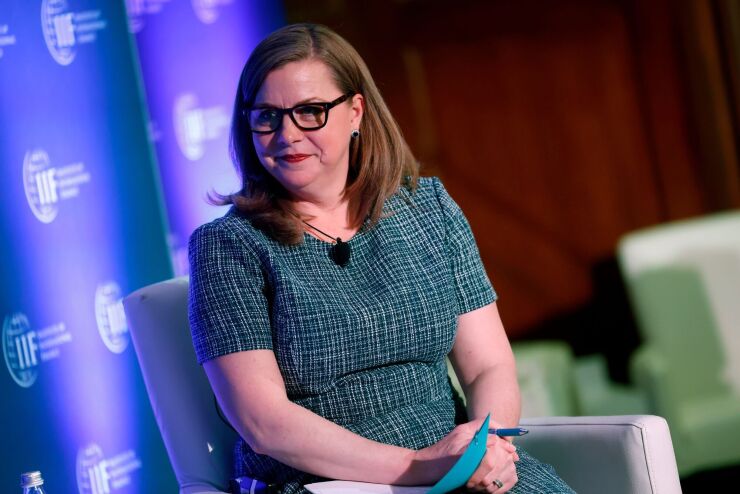
Federal Reserve Gov. Michelle Bowman said the central bank might have been
In a Tuesday morning speech at a conference hosted by the Bank of Japan, Bowman noted that the level of reserves — funds held at the Fed by commercial banks — remains roughly unchanged from where it was when the Federal Open Market Committee began its tightening campaign two years ago.
"In light of these conditions, I would have supported either waiting to slow the pace of balance sheet runoff to a later point in time or implementing a more tapered slowing in the pace of runoff," she said.
Later this week, the Federal Open Market Committee will significantly cut the pace of its
The FOMC voted unanimously to slow the pace of balance sheet reduction during its meeting earlier this month.
The Fed will keep the runoff cap on mortgage-backed securities at $35 billion, though these assets have been maturing relatively slowly. Depressed volumes of home sales and mortgage refinancings have made it difficult for the Fed to reach its monthly MBS runoff cap.
During her speech, Bowman said QT has progressed smoothly thus far, with the reduction of assets — and therefore liabilities, too — taking place without issue. At some point, she said, this reduction effort will cause the supply of reserves to fall from their current "abundant" level to the "ample" level targeted by the FOMC.
Should reserves dip below abundant or become scarce for certain banks, banks could face higher funding costs, potentially disrupting the function of monetary policy. Yet, while avoiding scarcity is important, Bowman said the Fed's priority should still be on rightsizing its holdings.
"In my view, it is important to continue to reduce the size of the balance sheet to reach ample reserves as soon as possible and while the economy is still strong," she said. "Doing so will allow the Federal Reserve to more effectively and credibly use its balance sheet to respond to future economic and financial shocks."
The Fed's balance sheet peaked at $8.9 trillion in March of 2022. It has since fallen to less than $7.3 trillion, though it remains roughly $3 trillion bigger than where it was before the Fed's latest round of quantitative easing, or QE, kicked in at the onset of the COVID-19 pandemic.
Bowman said the Fed's QE initiative in 2020 helped bolster the economy and enable continued market function through a period of stress, but she questioned whether the policy was too accommodative in light of the various fiscal supports provided by the federal government. She added that, in hindsight, the Fed should have considered ending QE sooner than it did.
"My own view is that the FOMC would likely have benefited from an earlier discussion and decision to begin tapering and subsequently end asset purchases in 2021 given the signs of emerging inflationary pressures," she said. "Doing so would have allowed the FOMC the option to have begun to tighten monetary policy earlier by raising the target range for the federal funds rate."
Moving forward, Bowman said the Fed has important decisions not only about the size of its balance sheet, but also the composition.
She said she encourages the FOMC to maintain its policy of reinvesting any MBS runoff in excess of its $35 billion cap into Treasuries with an eye toward having a balance sheet that consists of
"It will be important to consider such potential costs and benefits to the Federal Reserve's Treasury securities maturity structure and the best ways to achieve the desired maturity structure over time," she said.
